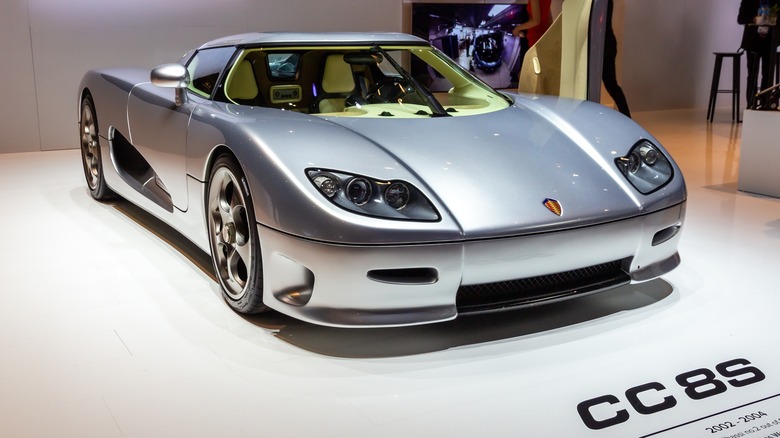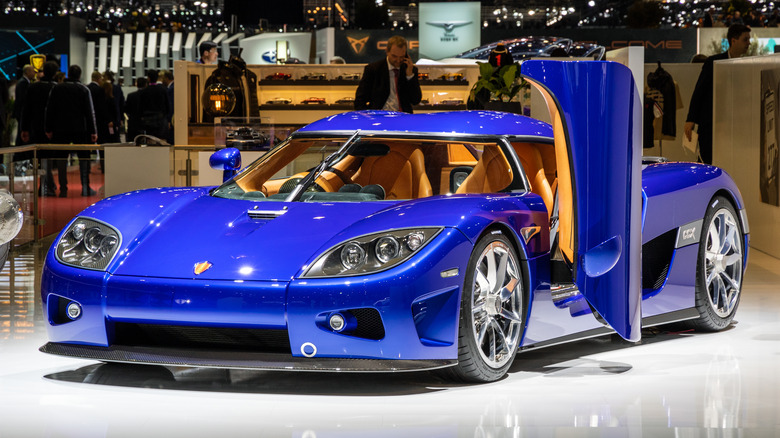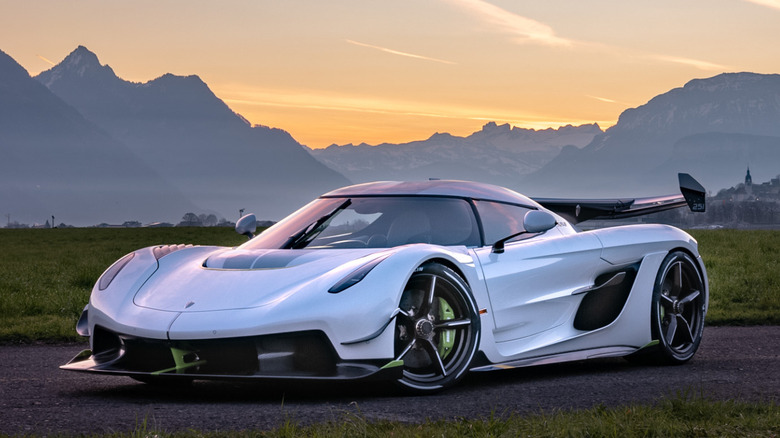How Koenigsegg Turned A Ford V8 Into An Engineering Marvel
Koenigsegg has done wonders with one of Ford's V8 engines. This development story involves a dedicated pursuit of ungodly amounts of power way beyond what this engine was ever intended to produce. The Koenigsegg's efforts yielded a powerplant that was far beyond the original Ford modular V8 that the company started with. This engine has powered many of Koenigsegg's fastest cars.
Koenigsegg first used this engine in the CC8S(for Competition Coupe V8 Supercharged), shown above. This car was the brand's first production model and used a 4.7-Liter supercharged version of the Ford modular V8, one of the most impressive Ford engines ever built.
The engine was extensively modified by Koenigsegg, and featured a dry sump 12-liter lubrication system, a carbon fiber cam cover, and a supercharger running at 1.2 bar of boost. The V8's output was 655 horsepower and its redline was set at 7,250 rpm.
The mid-engine Koenigsegg CC8S could accelerate from zero to 60 mph in 3.3 seconds and cover a quarter mile from a standing start in 10 seconds with a trap speed of 135 mph. Top speed was 240 mph. The CC8S broke the McLaren F1's Guinness record as the world's most powerful production car.
The Ford V8's limitations pushed Koenigsegg in another direction
The CC8S was followed in 2004 by the CCR, which used the final version of the Ford V8-based engine. The CCR added a second supercharger, boosting its output to 806 horsepower. This was over 150 horsepower more than the CC8S, which resulted in another Guinness World Record in 2004 for the CCR's engine. The Koenigsegg CCR also claimed the record of world's fastest car in 2005, displacing the McLaren F1 in this category as well. The CCR achieved a top speed of 241 mph at the test track in Nardo, Italy.
For the Koenigsegg models that would succeed the CCR, the company needed more power. Attempts to tune the Ford engine for higher power levels made it unreliable, prevented it from passing emissions regulations, and required a steady diet of racing fuel. All of these issues were unacceptable for a manufacturer of high-performance hypercars looking for a worldwide audience.
Koenigsegg began taking the engine beyond Ford's design. Formula 1 supplier Grainer and Worrall made new engine block castings to Koenigsegg's specs, retaining little more than the 90-degree angle and cylinder bore spacing. Displacement was kept at 4.7 liters, but nearly everything else was optimized for the engine's hypercar mission. Even better, it could meet California Air Relations Board (CARB) emissions standards along with worldwide safety regulations. The new engine debuted in the Koenigsegg CCX, the first Koenigsegg to be sold in the U.S.
Koenigsegg pushed the engine well past 1,000 horsepower
As the Koenigsegg lineup grew over the years, the company's engine continued to evolve. The 2007 CCXR could run on either gasoline or higher-octane E85, a mixture of 85% ethanol and 15% gasoline. When running on E85, the CCXR's engine could put out 1,018 horsepower, a new record.
For the 2010 Agera, Koenigsegg switched from the previous twin-supercharger setup to twin turbochargers. Combined with a new exhaust system designed to reduce any turbo lag to a minimum, the Agera's engine now produced 960 horsepower on pump gas. The 2011 Agera upped the E85-fueled output to 1,140 horsepower, while the 2012 Agera S was capable of 1,000 horses on pump gas.
Koenigsegg released the ONE:1 in 2014, naming the car for its power-to-weight ratio of one horsepower per kilogram. This hypercar weighed 1,360 kg and produced 1,360 horsepower running on E85. In 2015, the ONE:1 set lap records at the Suzuka and Spa racetracks. The 2015 Agera RS took the production car speed record from Bugatti, thanks to its 1,160 horsepower engine.
The most recent chapter of the Koenigsegg engine saga saw the 2019 introduction of the Jesko, named for founder Christian von Koenigsegg's father. The Jesko features a newly-designed 5.0-liter version of the Koenigsegg twin-turbocharged V8 engine, which produces 1,280 horsepower on pump gas and 1,600 horsepower on E85. In 2023, production specifications for the all-wheel-drive gasoline-electric hybrid Gemera were announced. It will be the most powerful production car to date, combining its 1,500 horsepower V8 with an 800 horsepower electric motor for 2,300 horsepower total.


